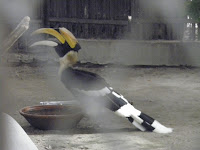
 I still muse on the Qutb Minar Complex, an archeological site whose architecture spans the rise and fall of the Islamic empire in India. But there is a small, significant Hindu presence here - see the end of this blog.
I still muse on the Qutb Minar Complex, an archeological site whose architecture spans the rise and fall of the Islamic empire in India. But there is a small, significant Hindu presence here - see the end of this blog.
This two photos are of the Qutb Minar itself, which was rather like the Eiffel Tower of its day, I suppose, in terms of technology. It was intended to be a symbol of Islamic dominance in India. Below are some of the beautifully detailed carving on the structures themselves. Once again we see the delicate yet exuberant Indo-Islamic patterns in the stone carving on the tower walls.
I have to say, Islam at its height in India was a graceful culture in its art, literature, and music. Even in science.

In Madhur Jaffrey's lovely cookbook A Taste of India, she reminisces about picnics with her extended family in the Qutb Minar Complex. We did not see picnics that day with the premonsoon heat, yet the grass and the hilly expanses were pretty green (despite the picture) and people certainly came out.

As usual there were tombs as well as old mosques in this cheerful place. Birds flew around in the high ceilings. Have I already said that the tombs were like final gifts of beauty from the dead rulers to their people?
Here I am in the hat that Usha so disliked. I do look pretty dowdy, but I was too entranced by the sights to notice at the time!!
Still, I highly recommended such a hat when travelling in the sun in India.
Doodling everywhere in the world.
Ah, here is the symbol of the decline of the Islamic empire, the tower that was intended to be twice as tall as the Qutb Minar, but was left unfinished - lack of money, I believe. Shocking to extrapolate just how tall it could have been, just from the dimensions of this base.
In the middle of this expanse of crumbling ornate architecture is a Hindu remnant, an simple iron pillar from a Vishnu temple. It has not rusted in 2000 years, and to date no one knows why. The pillar is over 99% iron. Also. it's not that dry here. We were drenched when the monsoon arrived the next week. So why has it not rusted? That's the Qutb Minar on the left, in the photo on the right.
I think of this pillar as symbol the Hindu culture which was here when the Moghuls came, and was still vibrant when the empire fell.
















































